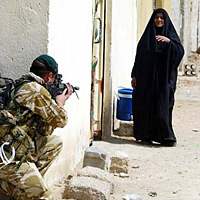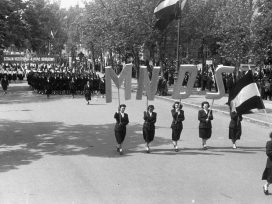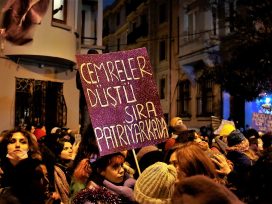 Since the 1950s, a massive influx of labour migrants has dramatically transformed the demographic makeup of Europe. Whether they came as guest workers or former colonial subjects, migrants from North Africa, South Asia and Turkey produced the first significant Muslim communities within Europe. During the half century that these groups have resided in Europe, the national debates about their presence have changed radically. Broadly speaking, public discussions initially focused on the economic manpower and the impact of employing migrants on the native working class. As Europeans began to acknowledge that temporary labourers had become permanent residents, political discourse shifted to migrants’ cultural differences based on their nationality. Since the 1990s, the emphasis has been on religion (especially Islam) as the primary characteristic that separates these migrants from the societies in which they reside. “Islamophobia”, in short, has emerged as “the defining condition of the new Europe”.
Since the 1950s, a massive influx of labour migrants has dramatically transformed the demographic makeup of Europe. Whether they came as guest workers or former colonial subjects, migrants from North Africa, South Asia and Turkey produced the first significant Muslim communities within Europe. During the half century that these groups have resided in Europe, the national debates about their presence have changed radically. Broadly speaking, public discussions initially focused on the economic manpower and the impact of employing migrants on the native working class. As Europeans began to acknowledge that temporary labourers had become permanent residents, political discourse shifted to migrants’ cultural differences based on their nationality. Since the 1990s, the emphasis has been on religion (especially Islam) as the primary characteristic that separates these migrants from the societies in which they reside. “Islamophobia”, in short, has emerged as “the defining condition of the new Europe”.
A striking aspect of contemporary European debates about immigrants is the focus on the Muslim woman as a key figure through which objections to Islamic difference have been articulated. This gendered framing of difference is not a new phenomenon. Indeed, the distinctive gender norms of postwar migrants became a major theme once significant numbers of family reunions had taken place in the early 1970s. But recent pronouncements by figures such as the Somali-Dutch politician Ayaan Hirsi Ali and the Turkish-German sociologist Necla Kelek about the place of women in Islam have inflamed the debate. Their highly sensational testimonials of female oppression under Islam have fuelled the tendency to characterize tensions between Muslim immigrants and Europeans as irresolvable. Muslim gender relations now serve as the most telling symptom of the supposedly intractable clash between European civilization and Islam.
Precisely because sexual politics plays such a critical role in defining the terms of the current pessimism about Muslims in Europe, it is important to trace when and how this process began, especially in relation to the shifting national public discourses on labour migrants over the past fifty years. In the Federal Republic of Germany, these issues became a major topic of public discussion in the late 1970s, at the moment when West German officials first openly acknowledged the long-term presence of guest workers and initiated a campaign for their integration. Turkish women quickly became a central trope for representing the apparent incommensurable cultural difference between Turks and Germans, and West German feminists played an important role in facilitating this line of thinking. By the early 1980s, the putative “oppression” and “victimization” of Turkish women offered evidence of an unbridgeable chasm between guest workers and Germans. The treatment of women became a litmus test to determine whether Turks possessed the capacity to integrate into the liberal-democratic Federal Republic.
Significantly, West German debates over the plight of Turkish women lent substance to new concerns about Islam as a highly problematic, differentiating social force, concerns that began to be voiced throughout Europe in the early 1990s. Examining the German discourse about the perceived predicament of Turkish women, then, not only helps us understand the specific preconditions for guest worker integration set out by left-wing progressives in the Federal Republic, but also sheds light on the emergence of a broader European phenomenon: the current scepticism about the compatibility of Muslims with Western civilization.
The Federal Republic began recruiting guest workers to address a manpower shortage created by the economic miracle. Initially, it signed a labour recruitment treaty with Italy in 1955, and subsequently concluded agreements with Spain, Greece, Turkey, Portugal, and Yugoslavia throughout the 1960s. By the fall of 1964, the number of foreign workers in West Germany surpassed one million; five years later, the figure had almost doubled. In 1973, when the Federal Republic officially ended recruitment, the number reached nearly 2.6 million.
Despite the high numbers, West Germans remained largely untroubled by the presence of guest workers during the period of active recruitment (1955-73). Government leaders, policy makers, employers, and newspaper commentators vigorously championed the use of foreign labour as a necessary strategy to keep economic production high. There was no sense that guest workers might eventually become a domestic social problem because everyone involved in recruitment assumed that labour migrants would inevitably return home. This perspective was partially conditioned by the formal parameters of the programme. The treaties stipulated two-year work permits for all recruits. The Labour Office favoured young men who were either single or willing to leave their families at home. And employers provided rudimentary housing in barracks, generally far removed from city centres and the eyes of ordinary Germans. These conditions effectively framed the labour migration as a temporary expedient for the lack of native manpower. In addition, West Germany defined citizens as those with German blood, which precluded foreign labourers from obtaining citizenship through naturalization. This definition reinforced the message that the guest worker programme was not a route to permanent immigration.
However, over the course of the 1970s, significant economic and demographic changes transformed the ways that Germans thought about guest workers. The worldwide oil crisis of 1973 sent the West German economy plummeting and prompted the government to issue an Anwerbestopp to halt all foreign labour recruitment. Contrary to expectations, the suspension of the guest worker programme spurred the arrival of spouses and children who feared that the country would close its borders for good. By the end of the decade, the number of foreigners living in West Germany reached 4 million. Turks, moreover, surpassed Italians as the largest group of foreign labourers in the late 1960s. And as their numbers mounted during the 1970s, they came to personify the guest worker in German public debates about the labour migration and its impacts.
These developments led political authorities in 1979 to acknowledge that temporary labourers had become de facto immigrants. Official recognition of guest workers as long-term residents, in turn, fuelled government-sponsored research on labour migrants’ social situation, economic circumstances and cultural customs, previously dismissed as unnecessary. The shift from viewing guest workers under the aegis of labour policy to seeing them as a legitimate and significant domestic issue led to new policies to promote the integration of foreign labourers into West German society.
The changing perception of guest workers also affected the ways that gender issues entered public discussion. In the period of active recruitment (1955-73), the male worker dominated the German public imagination. News reports described foreign men, detailing their traits with regard to labour: diligence, discipline, thrift, modesty, adaptability, and industriousness. Meanwhile, human-interest pieces speculated on the masculinity of “southern” (e.g., Mediterranean) workers who were “passionate” and “temperamental”, as well as physically attractive and sexually potent. After 1965, the Federal Republic actively began recruiting foreign women for the textile, food, and electronics industries. This new group of workers combined with the dramatic increase in family reunions drew attention to migrant women in the 1970s. By the end of the decade, there was a veritable explosion in the number of German-language publications about female migrants.
One major sub current in this literature was government-funded research conducted by academics. Here, scholars repeatedly noted that migrant women experienced overwhelming isolation and oppression in the Federal Republic, suffering from such feelings much more acutely than their husbands or children. A 1977 study explained that women from Italy, Greece, Yugoslavia and Turkey all lived with some form of gendered spatial segregation in West Germany. Based on survey results, the author declared that the quantitative differences among nationalities were negligible and concluded that going out was possible for most of these women accompanied by a man.
Much of the scholarship emphasized structural causes over fundamental cultural differences for female migrants’ isolation. One study suggested that the strict separation of male and female worlds gave Turkish women “security” and a “sense of belonging” in their homeland. In addition to providing them with clear roles and a place in the family hierarchy, gender segregation fostered a strong sense of solidarity among women. The cultural practice of separating men and women, in other words, did not itself produce female isolation and oppression. Rather, this situation developed in the process of migration. The move to West Germany cut Turkish women off from their familiar village milieu and created language barriers that made communication beyond the immediate family circle virtually impossible. Relocation to a country with radically different social norms, furthermore, often provoked fathers or husbands to regulate their movements far more strictly than at home.
In the first half of the 1980s, however, these more nuanced efforts at cultural understanding were overshadowed by a recurring trope of the imprisoned, helpless Turkish woman. Here, the focus was explicitly on Turks, as the quintessential guest worker group, rather than on the full spectrum of migrants. The trope itself was inextricably connected to the emergence of a new context for the guest worker question: the popular genre of “reportage”. Indeed, the movement of guest worker representations (especially discussions of Turkish women) into the domain of readily accessible, journalistic treatments of contemporary social problems fuelled the new trope’s force.
An early example of reportage on Turkish women was Andrea Baumgartner-Karabak and Gisela Landesberger’s 1978 Die verkauften Bräute: türkische Frauen zwischen Kreuzberg und Anatolien (Sold Brides: Turkish Women between Kreuzberg and Anatolia), published by Rowohlt Verlag. The fact that a popular press like Rowohlt exhibited interest in Turkish women suggests that public fascination with the migrant experience was entering the commercial mainstream. The book appeared in Rowohlt’s “Frauen aktuell” (contemporary women) series, and advertisements for the series as a whole ran in national feminist magazines such as Courage. This evidence indicates that the Rowohlt marketing department envisioned an audience of West German women and social workers sympathetic to leftist political causes and grassroots activism.
In the book’s foreword, well-known feminist Susanne von Paczensky explained the larger purpose of the project: to “make visible the difficulties and discrimination of Turkish women” in order to foster change. “Whoever wants to help or work with them,” she declared, “must first of all understand their situation, and that can only happen when one knows about their origin.” To some extent, this project operated within a broader pattern of leftist discourse. Like the scholarly studies, Die verkauften Bräute looked to the country of origin, and especially the social customs of the village, to diagnose the problems migrant women faced in Germany. In the academic works, the goal was to account for the impacts of the migration process on women by comparing social practices across cultures and contexts. The reportage, by contrast, focused exclusively on Turks, their social norms, and their cultural milieu. It presented Islam as the root cause of a fundamental problem within Turkish gender relations, referencing the Koran’s discrimination against women and citing the negative impact of religion on moral ideas and customary behaviour. Women’s lives, according to authors Baumgartner-Karabak and Landesberger, were “predetermined”, decisions were “made for them” and their “social place” was fully defined by the men around them. Islamic custom, in this view, left virtually no room for individual, female agency.
The point was less to critique village practices or religious prescriptions than to comment on their transfer to Germany via the labour migration. In the foreword, Paczensky instructed German readers to consider the book’s information about village culture in relation to the behaviour of the migrant women in their midst. Turkish women inhabit Germany, she declared, as “inassimilable, strange bodies”, who “walk humbly two steps behind their husbands”, cede the “traditional” female domain of “shopping to their husbands and children”, and above all, fail to “meet emancipated demands in their own ways of life”. Turkish women’s behaviour prevented them from fulfilling “traditional” female roles. More worrisome, their oppressed existence threatened the liberal, democratic values upheld by German feminists. The Islamic culture imported by Turkish women, in other words, contradicted the historical emancipation of European women.
While these cultural practices marked Turkish women as “strange”, even “inassimilable”, Paczensky’s emphasis on change indicated that they might be made assimilable. The goal was to extricate these women from customs and practices deemed illiberal or even destructive. But certain types of behaviour simply had to be discarded for integration into West German society to succeed. This stance was not unexpected since most of those working with migrants were self-identified feminists, who read the situation of Turkish women through the lens of their own struggles. The sight of women wearing headscarves, walking behind their husbands, and being cooped up in their homes undermined the basic gender equality for which West German feminists had fought so hard. What thus began as an expression of concern and a desire to study the problems of Turkish women in the Federal Republic eventually became an articulation of thresholds between West and East, progressive politics and reactionary tradition, feminist practice and unreformed patriarchy.
At the same time, invoking the language of liberal democracy enabled a more explicit articulation of racial or ethnic difference on the Left. Turks, the argument went, threatened to reintroduce reactionary behaviours into a country that had worked tirelessly to transform itself into a modern, staunchly democratic society. These foreigners endangered the nation not so much in the older sense of anxieties about Jews as harbingers of modernity, capitalism, and liberalism. Turks, instead, posed the opposite problem. Perceived as clinging to backward customs and social practices, they potentially undermined West Germany’s hard-won emancipation from Nazi ideology, especially in terms of women’s rights, marriage and relations between the sexes. It was therefore by making these kinds of progressive claims that leftists – so wary of Nazi racism – began to draw harder distinctions between Germans and Turks. Ironically, official acknowledgment of guest workers as de facto immigrants not only paved the way for large-scale integration efforts, but also opened the door for articulations of essential difference that had been unnecessary as long as migrants were understood as firmly outside the German social body.
Since the mid-1980s, a number of major events have further shaped Germany’s relationship to its Turkish population. As communism crumbled, the Federal Republic quickly granted citizenship to ethnic Germans from Eastern Europe, most of whom possessed little or no knowledge of the German language, culture, or customs. Yet it continued to resist revising the nation’s naturalization laws to facilitate the legal incorporation of Turks born, raised, and educated in West Germany. The fall of the Berlin wall in 1989 and the unification of the two Germanys in 1990, moreover, produced intense public discussions about German national identity. But these debates largely excluded Turks, and German interlocutors often seemed oblivious to the ways that Turkish immigrants necessarily had a stake in the definition of German identity and the future of the nation. Certainly the most chilling expression of nationalist sentiment was the spate of xenophobic violence that occurred in both eastern and western parts of Germany. From 1991 to 1993, right-wing extremists carried out a series of vicious assaults to the chorus of “Foreigners out” and “Germany for the Germans”. The attacks targeted longtime residents from Turkey, as well as contract labourers recruited by the former GDR and asylum seekers.
More troubling, perhaps, than the violence itself was the government’s response. Public officials lumped the entire spectrum of victims into the category of “foreigner”. The Federal Interior Minister characterized the incidents as “antiforeigner” and attributed the violence to the massive influx of refugees. The only solution was to stem their flow. This strategy of combating xenophobia by blaming refugees dominated Germany’s domestic agenda, as the federal government doggedly pursued a revision of the country’s liberal asylum law. It also enabled politicians to sidestep a potentially divisive discussion about the vast majority of foreigners, primarily long-time resident Turks. In this way, the reinscription of Turks as “foreign” was part of a larger effort to manage the unanticipated dilemmas of reunification.
During these same years, the process of European unification opened up a continent-wide discussion about cultural belonging that radically recontextualized Germany’s understanding of its Turkish population. With the influx of legal and illegal migrants to European Union (EU) states throughout the 1990s, attention initially focused on developing a common immigration policy, which led critics to accuse the EU of creating “Fortress Europe”. Alongside this policy debate emerged a conversation about a collective European identity. Indeed, the establishment of the EU implicitly raised fundamental questions about who counted as European and what a shared culture and common values might look like. If this attempt to define a European identity began in the midst of a siege mentality, a sense of being flooded by refugees and illegal immigrants, it was also conditioned by the presence of significant ethnic minority communities already rooted in every major European metropolitan centre. A common sense of Europeanness thus took shape in relation to both foreigners pressing from without and people perceived as foreign from within.
These discussions of migration and identity, moreover, facilitated a growing awareness among EU states about the similar challenges posed by their postwar migrant populations. In this way, the German debate over Turkish integration became part of a much larger conversation about immigrants in Europe. But the new context also changed the nature of the discourse: the impulse to look for common patterns and shared difficulties underscored the fact that the most visible migrants, country by country, were Muslim. This was not only true of the initial postwar migration of guest workers and postcolonials, but also of the wave of refugees and asylum seekers in the 1970s and 1990s. Even the Balkan crises pitted Bosnian and Albanian Muslims against Christian Serbs and Croats. As a result, Muslims quickly became the primary field against which Europe’s self-definition took place.
In Germany, the older habit of assessing Turks’ ability to integrate in terms of the plight of women continued, but after the mid-1990s the emphasis shifted to the Muslim status of the Turkish minority. Religion, in other words, emerged as an important marker of difference in public discourse. But the appearance of religion was much less a new development than a repurposing of old tropes to deal with novel historical conditions. Consider the eminent German historian Hans-Ulrich Wehler’s reaction to the prospect of incorporating Muslim Turkey into the EU. Questioning the capacity of Muslim Turks to participate in liberal democracy, he described a sensational scene of Anatolians amassing on the frontier in anticipation of the opening of the EU’s labour market. Wehler thus revived one of the Enlightenment’s oldest tropes of absolute difference, comparing 65 million contemporary Turks to Ottoman hordes at the gates of Vienna.
Since 9/11, efforts to construct a shared European identity have increasingly been conducted in a civilizational register. As part of the 2003 European opposition to the Iraq war, German philosopher Jürgen Habermas and his French counterpart Jacques Derrida issued an urgent plea for a common European vision grounded in the shared heritage of Western civilization. The Italian author Umberto Eco’s contribution to this call included an inventory of core European characteristics based on the Enlightenment project of modernity. The initiative was an unself-conscious exercise in boundary drawing and cultural demarcation. Yet this public naming of values, traditions, and histories effectively marked the line much less between Europe and the United States (the effort’s ostensible target) than between Europe and its Muslim minorities. The security anxieties produced by 9/11 and its aftermath only exacerbated this inclination, explicitly transforming Muslims and Islam into the fundamental contemporary threat to European society and culture. “At the high tide of Europeanism, glued together by the so-called war on terror”, in short, “there emerged an in-turned and recentred pan-European, anti-Islamic racism.”
In this tendency to fixate on intractable differences between European civilization and Islam, gender relations have remained a crucial focal point. In 2003, France passed the Stasi law that forbade the wearing of conspicuous religious symbols (especially the foulard) in public schools. By banning the headscarf, the French state presented Muslim women (by extension, all Muslims) with a “definitive” choice: “There would no longer be compromises or mediation – it was either Islam or the republic.”
Two years later, several German states designed a citizenship test specifically for applicants from Muslim majority countries. Proposed questions included: Do you find it acceptable for a man to lock up his wife or daughter to prevent her from “shaming” him in public? What would you do if your son announced that he was homosexual and wanted to live with his boyfriend? To qualify for German citizenship, applicants had to endorse not only gender equality, but also sexually modern norms. Gender equality and modern views on sexuality, that is, served as evidence of German tolerance and the crucial indicator of Muslim intolerance. Just like the Stasi law, this test forced a decisive choice: retrograde Islam or progressive German citizenship.
During the 1980s, West German feminists raised concerns about Turkish gender relations in the context of debating the parameters of integration. While these leftists identified unacceptable customs and behaviours within Turkish culture, they were nonetheless committed to cultural reform and the mutual coexistence of Turks and Germans. More recently, efforts to define a European identity have pitted an enlightened West against an antimodern Islam. What has changed in recent years above all is the epistemological starting point of cross-cultural engagement, a process that during the 1980s and 90s assumed reciprocality and mutual adaptation, but now often begins with relatively fixed litmus tests for adaptability on one side of the cross-cultural divide. In this sense, the terms of public debate in both Germany and Europe have become increasingly fixed, nonnegotiable, and unidirectional in their lines of acculturation.

 Since the 1950s, a massive influx of labour migrants has dramatically transformed the demographic makeup of Europe. Whether they came as guest workers or former colonial subjects, migrants from North Africa, South Asia and Turkey produced the first significant Muslim communities within Europe. During the half century that these groups have resided in Europe, the national debates about their presence have changed radically. Broadly speaking, public discussions initially focused on the economic manpower and the impact of employing migrants on the native working class. As Europeans began to acknowledge that temporary labourers had become permanent residents, political discourse shifted to migrants’ cultural differences based on their nationality. Since the 1990s, the emphasis has been on religion (especially Islam) as the primary characteristic that separates these migrants from the societies in which they reside. “Islamophobia”, in short, has emerged as “the defining condition of the new Europe”.
Since the 1950s, a massive influx of labour migrants has dramatically transformed the demographic makeup of Europe. Whether they came as guest workers or former colonial subjects, migrants from North Africa, South Asia and Turkey produced the first significant Muslim communities within Europe. During the half century that these groups have resided in Europe, the national debates about their presence have changed radically. Broadly speaking, public discussions initially focused on the economic manpower and the impact of employing migrants on the native working class. As Europeans began to acknowledge that temporary labourers had become permanent residents, political discourse shifted to migrants’ cultural differences based on their nationality. Since the 1990s, the emphasis has been on religion (especially Islam) as the primary characteristic that separates these migrants from the societies in which they reside. “Islamophobia”, in short, has emerged as “the defining condition of the new Europe”.




